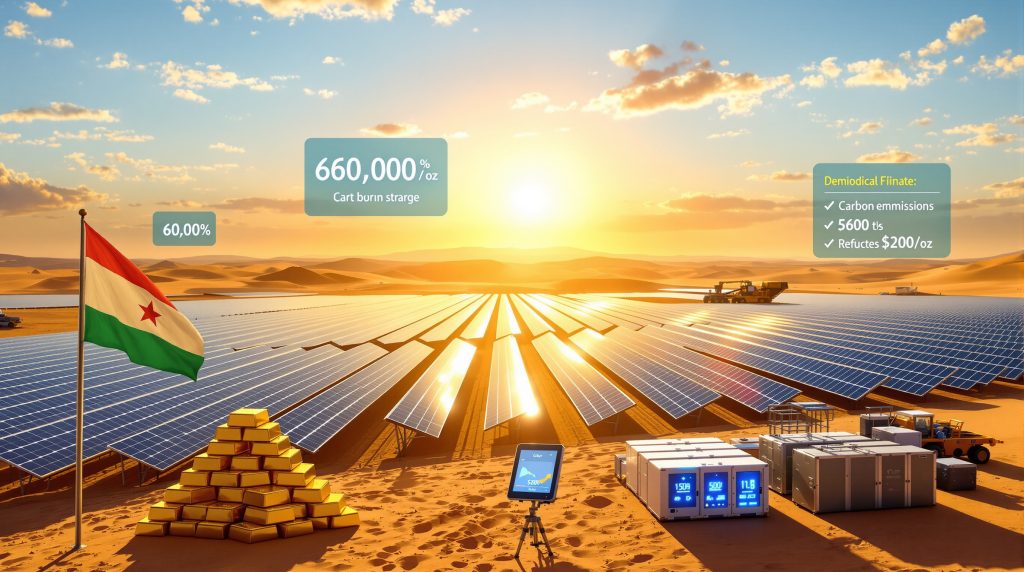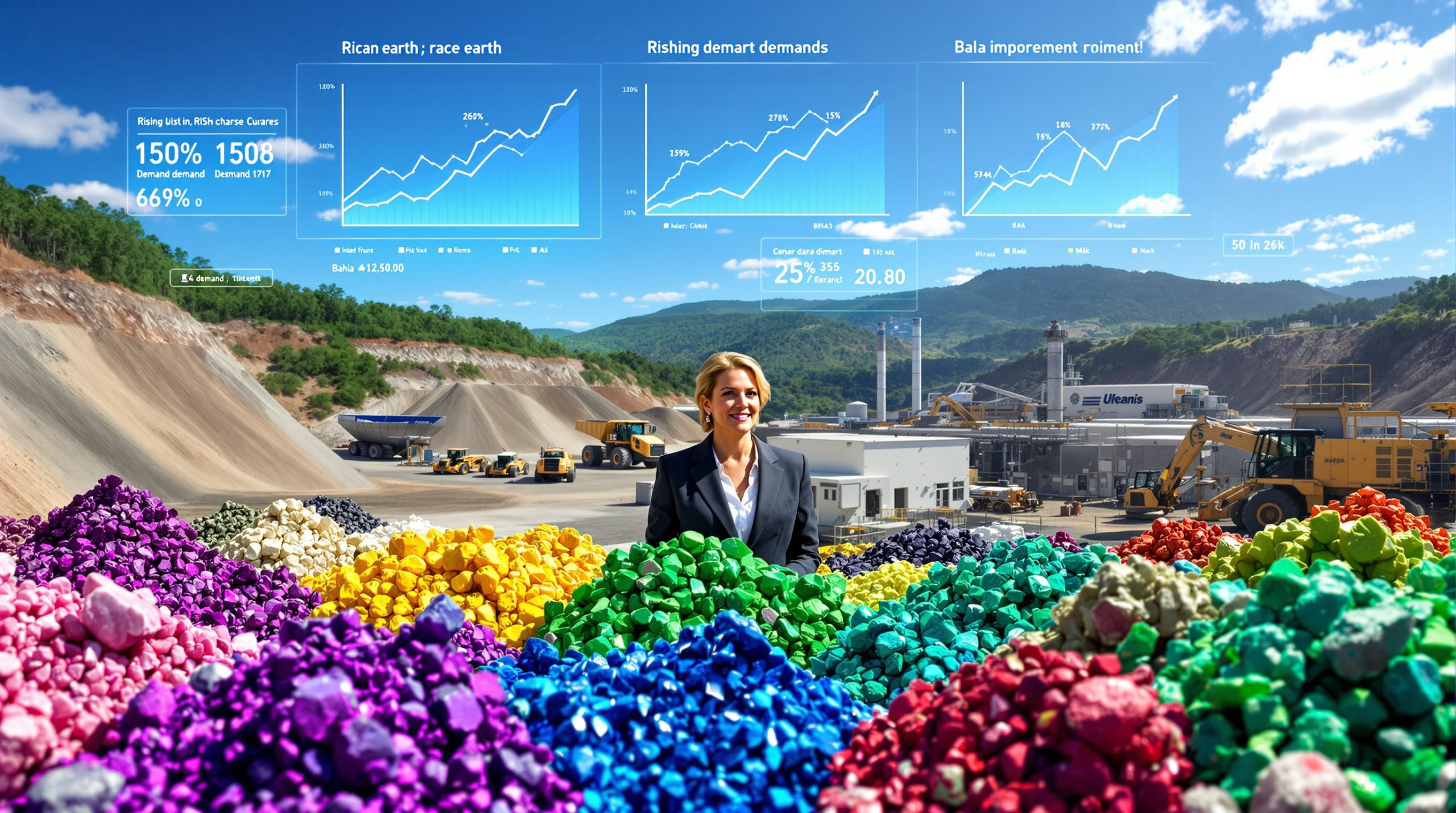Renewable Energy Revolution at Sadiola: Allied Gold's Solar Power Initiative
Allied Gold is implementing a comprehensive three-year integrated energy program at its Sadiola gold mine in western Mali. This strategic initiative, scheduled for 2026-2028, aims to secure reliable power supply while simultaneously reducing operational costs and environmental impact. The company has partnered with African Power Services (APS) to support the mine's phased expansion through renewable energy integration, representing one of West Africa's most ambitious mining sustainability projects.
The program demonstrates Allied Gold's commitment to operational resilience and environmental stewardship while addressing persistent energy challenges in Mali's mining sector. By transitioning to renewable energy, the company aims to enhance the long-term viability of its operations at Sadiola.
Current Energy Challenges in Mali
Mali faces persistent electricity shortages that significantly impact industrial operations across the country. According to the World Bank, the nation's installed electricity generation capacity stood at approximately 789 MW as of 2022, with businesses reporting estimated annual losses of 4-6% of sales due to unreliable power.
The country's national grid relies heavily on imported petroleum, creating vulnerabilities for energy-intensive sectors like mining. The International Energy Agency (IEA) reports that Mali's electrification rate was approximately 48% in 2022, with significant urban-rural disparities. The grid's reliability issues stem from heavy dependence on thermal generation (approximately 60% of capacity) and limited hydroelectric resources vulnerable to seasonal rainfall variations.
These challenges have prompted mining companies to seek alternative power solutions that offer greater reliability and cost efficiency, particularly in remote regions where grid connections are unreliable or entirely absent.
Phase 1: Stabilizing Power Infrastructure (2026)
The initial phase of Allied Gold's energy program focuses on establishing a stable power foundation through several critical improvements:
- Installation of 14 MW of modern diesel generators to replace aging equipment
- Reinforcement of existing power infrastructure to handle future capacity expansions
- Creation of a reliable baseline power supply to support consistent operations
- Implementation of systems designed for eventual renewable integration
This first step addresses immediate power stability needs while laying the groundwork for the renewable transition to follow. By modernizing the thermal generation components, Allied Gold aims to improve efficiency even before introducing solar capacity, creating immediate operational benefits.
What Renewable Technologies Will Power the Sadiola Mine?
The second phase of Allied Gold's energy program introduces significant renewable capacity to transform the mine's power generation profile, leveraging Mali's abundant solar resources.
Phase 2: Solar and Battery Integration (2027)
In 2027, Allied Gold will deploy an advanced renewable energy system consisting of:
- 35 MW solar power plant utilizing modern photovoltaic technology
- 30 MWh battery energy storage system for load management and stability
- Advanced integration systems connecting renewable and thermal generation
- Smart grid management technology to optimize energy usage patterns
This hybrid system represents one of West Africa's largest mining-focused renewable energy installations. According to the International Finance Corporation (IFC), solar PV installations at African mine sites grew from approximately 15 MW in 2012 to over 800 MW by 2023, representing a compound annual growth rate of over 40%.
The battery storage component will help manage intermittency issues typically associated with solar generation. Bloomberg New Energy Finance reports that battery pack prices fell from $1,200/kWh in 2010 to approximately $139/kWh in 2023, making battery recycling solutions economically viable for mining applications in remote locations.
Phase 3: Expansion and Optimization (2028)
The final phase will further enhance the renewable footprint through significant capacity expansions:
- Introduction of medium-speed thermal units for improved efficiency during non-solar periods
- Expansion of solar capacity to 60 MW, nearly doubling the initial installation
- Increase in battery storage to 45 MWh to support greater renewable penetration
- Implementation of advanced power management systems to optimize the hybrid configuration
By project completion, the renewable components will deliver approximately 40% of the mine's total power requirements, significantly reducing dependence on fossil fuels. This aligns with global energy transition strategies as the Responsible Mining Foundation reported in 2023 that 40% of large-scale mining operations worldwide have implemented or committed to renewable energy projects.
What Economic Benefits Will the Solar Power System Provide?
The renewable energy initiative delivers multiple financial advantages that strengthen Sadiola's operational economics and competitive position in global gold markets.
Cost Reduction Projections
| Timeline | Cost Reduction | AISC Impact | Power from Renewables |
|---|---|---|---|
| Initial Implementation | 20% | $150/oz reduction | 25% |
| Full Deployment | 45% | $200/oz reduction | 40% |
These projected cost savings are substantial in the context of industry benchmarks. According to the World Gold Council's 2023 analysis, average global all-in sustaining costs (AISC) for gold producers ranged from $800-1,400/oz in 2023, with energy typically representing 15-30% of total mining costs. A reduction of $150-200/oz in AISC represents approximately 10-15% improvement for mid-cost producers, potentially transforming Sadiola's competitive position.
The Rocky Mountain Institute's analysis of off-grid hybrid systems indicates that solar-battery-diesel hybrids can achieve levelized cost of electricity (LCOE) of $0.15-0.30/kWh in African contexts, compared to diesel-only systems at $0.30-0.50/kWh. This significant differential explains the compelling economics behind Allied Gold's investment.
Financing Structure
Allied Gold has structured the project financing to minimize upfront capital requirements while maintaining implementation momentum:
- Deferred payment arrangements for initial installations to preserve capital
- Phased capital deployment aligned with production increases at Sadiola
- Power purchase agreement (PPA) components for certain infrastructure elements
- Operational savings from early phases funding later expansion stages
This approach preserves capital for core mining operations while still enabling the energy transition. The company reports expected payback periods of 3-7 years for the solar-diesel hybrid system, consistent with industry benchmarks for similar projects in the region.
How Does This Initiative Impact Sadiola's Environmental Footprint?
The renewable energy program delivers substantial environmental benefits alongside its economic advantages, supporting global mining sustainability trends.
Emissions Reduction
The solar and battery system will significantly reduce the mine's carbon emissions through multiple mechanisms:
- Decreased diesel consumption by approximately 20 million liters annually
- Carbon emissions reduction of up to 60,000 tonnes per year (based on EPA conversion factors)
- Reduced local air pollutants from combustion processes, including NOx, SOx, and particulate matter
- Lower environmental impact from fuel transportation and storage, including spill risks
These reductions align with calculations based on U.S. Environmental Protection Agency data, which indicates that burning one liter of diesel fuel produces approximately 2.68 kg of CO2. The 20 million liter reduction would therefore prevent approximately 53,600 tonnes of CO2 emissions annually, closely matching Allied Gold's projections.
Research published in the Journal of Cleaner Production found that solar-diesel hybrid systems at remote mines can reduce greenhouse gas emissions by 30-50%, with additional benefits including reduced local air pollution and noise.
Sustainability Benchmarks
This initiative positions Sadiola among the leading mines in West Africa for renewable energy adoption:
- One of Mali's largest private solar installations in terms of capacity
- Industry-leading battery storage deployment for mining applications
- Demonstration project showcasing renewable integration in remote operations
- Template for sustainable mining practices in challenging environments with limited infrastructure
Similar projects in the region include B2Gold's Fekola Mine in Mali, which installed a 30 MW solar plant with 15.4 MWh battery storage in 2021, providing approximately 20% of the mine's power requirements and reducing diesel consumption by 13.1 million liters annually.
What Does This Mean for Mining in West Africa?
Allied Gold's renewable energy investment at Sadiola represents a significant trend in the region's mining sector, potentially influencing industry practices throughout West Africa.
Regional Energy Independence
The project highlights growing efforts by mining companies to achieve energy sovereignty through several key mechanisms:
- Reduced reliance on fragile national grids that face chronic reliability issues
- Protection against fuel supply disruptions common in landlocked countries
- Mitigation of energy price volatility that impacts operational planning
- Enhanced operational resilience in regions with limited infrastructure
According to S&P Global Market Intelligence, West Africa attracted $1.2 billion in mining exploration expenditure in 2023, with gold representing approximately 70% of exploration spending in the region. Energy security represents a critical factor in investment decisions, with the Columbia Center on Sustainable Investment reporting that 60% of large mines in West Africa experience grid outages causing production disruptions.
Industry Transformation
This initiative signals broader changes in how mining operations approach power generation:
- Shift from diesel dependence to hybrid renewable systems that optimize multiple sources
- Growing recognition of renewable economics in remote locations with high solar potential
- Increasing integration of battery storage technologies to manage intermittency
- Rising importance of energy management in mining competitiveness and environmental compliance
The African Development Bank reports that renewable energy investments in African mining exceeded $2 billion cumulatively through 2023, with solar PV accounting for approximately 75% of renewable capacity additions. This trend reflects both economic incentives and growing pressure from investors and consumers for more sustainable mining practices.
How is Allied Gold Supporting Mali's Energy Transition?
The Allied Gold solar power Sadiola mine project aligns with Mali's broader energy objectives and provides benefits beyond the mine itself, contributing to national development goals.
National Energy Goals
Mali has established targets to diversify its energy mix and reduce petroleum dependence. The country's National Energy Policy aims to increase the renewable energy share to 39% of electricity generation by 2030 and add 1,000 MW of renewable capacity. Private investments like Allied Gold's contribute to these goals by:
- Demonstrating renewable viability in industrial applications and challenging environments
- Building technical capacity in renewable technologies through skills transfer
- Reducing national petroleum import requirements through decreased diesel consumption
- Creating models for future energy development in off-grid and mining contexts
Under its Nationally Determined Contribution (NDC) submitted to the UNFCCC, Mali committed to reducing greenhouse gas emissions by 31% by 2030 (conditional target), with renewable energy development serving as a key strategy to achieve this goal.
Community Benefits
The energy system may provide ancillary benefits to surrounding communities through multiple channels:
- Potential for community electrification initiatives in partnership with local authorities
- Skills development in renewable energy maintenance and operations
- Reduced environmental impacts from power generation, improving local air quality
- Demonstration of sustainable development principles that can be replicated elsewhere
The International Finance Corporation notes that private sector renewable energy investments often exceed government capacity in developing countries, with mining companies' installations serving as demonstration projects for renewable technology viability.
What Challenges Must Be Overcome for Successful Implementation?
While promising, the renewable energy transition at Sadiola faces several implementation challenges that require careful management and technical expertise.
Technical Considerations
The integration of solar, battery, and thermal systems requires addressing complex operational factors:
- Intermittency management during seasonal variations, as research on solar power in the Sahel region shows daily solar irradiance variation of 30-40% between summer and winter months
- Grid stability maintenance with fluctuating renewable inputs, particularly during transition periods
- Battery performance optimization in high-temperature environments, as studies indicate battery degradation rates increase by 0.5-1% per year for every 10°C above 25°C ambient temperature
- System optimization across multiple generation sources to maximize renewable utilization
According to IEEE standards for hybrid power systems, frequency regulation becomes critical with renewable penetration above 30%, requiring advanced power management systems for seamless switching between sources.
Operational Adaptation
The mine operations will need to adjust to new power realities through procedural changes:
- Alignment of high-energy activities with peak solar production periods when possible
- Maintenance protocols for new technology systems, including panel cleaning and battery management
- Staff training for renewable system management and troubleshooting
- Contingency planning for weather-related production variations and extended cloudy periods
B2Gold's experience with their Fekola solar project implementation identified several operational challenges, including grid stability management during transition periods, dust accumulation on solar panels requiring regular cleaning, training requirements for local technical staff, and supply chain logistics for replacement parts.
FAQ: Allied Gold's Solar Power Initiative at Sadiola
How much will the solar power system reduce operational costs?
The hybrid power system is projected to lower energy costs by 20% initially, increasing to 45% once fully deployed. This translates to a reduction in all-in sustaining costs of $150-$200 per ounce of gold produced, representing a significant competitive advantage in global gold markets.
What percentage of the mine's power will come from renewable sources?
By 2028, approximately 40% of Sadiola's power needs will be met through renewable energy. This percentage will fluctuate seasonally based on solar irradiance patterns, with battery storage helping to smooth these variations and maintain consistent supply.
How is Allied Gold financing this renewable energy initiative?
The company is utilizing deferred payment structures to limit upfront capital expenditure while maintaining project momentum. This approach allows operational savings from early phases to help fund later expansions, creating a self-reinforcing implementation model that preserves capital for mining operations.
Will the solar installation affect local communities?
While primarily designed to power mine operations, the project may create opportunities for community benefit through skills development, reduced environmental impacts, and potential power-sharing initiatives in surrounding areas. Specific community electrification programs associated with the project may be developed as implementation progresses.
How does this compare to other mining renewable energy projects in Africa?
This represents one of West Africa's largest mining-focused solar installations and demonstrates growing industry recognition of renewable energy's potential to enhance operational resilience while reducing environmental impact. Comparable projects include B2Gold's Fekola Mine in Mali (30 MW solar, 15.4 MWh battery) and AngloGold Ashanti's Sukari Gold Mine in Egypt (36 MW solar).
Further Exploration
Readers interested in learning more about sustainable mining practices in Africa can also explore related educational content available from the African Mining Market, which regularly covers developments in mining sustainability and renewable energy adoption across the continent.
The transition to renewable energy in mining represents one of the industry's most significant operational transformations, with implications for cost structures, environmental impact, and local development. Allied Gold's initiative at Sadiola provides a compelling case study in how mining companies can enhance their competitiveness while contributing to global sustainability goals through the integration of electric vehicles in mining and hydrogen-powered mining trucks alongside modern mine planning technology.
Looking for Early Alerts on Significant Mining Discoveries?
Discover how real-time notifications of major ASX mineral discoveries can transform your investment strategy with Discovery Alert's proprietary Discovery IQ model, delivering instant insights into actionable trading opportunities ahead of the market. Visit our dedicated discoveries page to understand the substantial returns potential of historic mineral finds.




